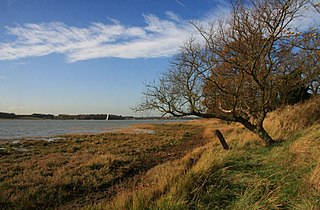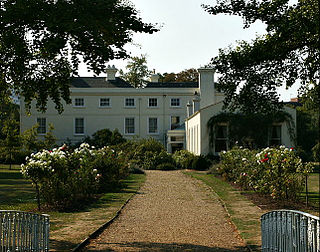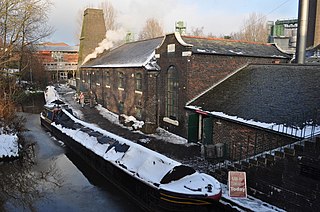
Ipswich is a historic county town in Suffolk, England. The town is located in East Anglia about 10 miles away from the mouth of the River Orwell and the North Sea. Ipswich is both on the Great Eastern Main Line railway and the A12 road, it is 66 miles (106 km) north-east of London, 54 miles east-southeast of Cambridge, and 45 miles south of Norwich. Ipswich is surrounded by two Areas of Outstanding Natural Beauty (AONB); Suffolk Coast and Heaths and Dedham Vale.

The River Orwell flows through the county of Suffolk in England. Its source river, above the tidal limit at Stoke Bridge, is known as the River Gipping. It broadens into an estuary at Ipswich, where the Ipswich dock has operated since the 7th century, and then flows into the North Sea at Felixstowe, the UK's largest container port, after joining the River Stour at Shotley forming Harwich harbour.

The River Gipping is the source river for the River Orwell in the county of Suffolk in East Anglia, England, which is named from the village of Gipping, and which gave its name to the former Gipping Rural District. The name is unrelated to the name of Ipswich. although the County Town takes its name from Gippeswic. It rises near Mendlesham Green and flows in a south-westerly direction to reach Stowmarket. From there it flows towards the south or south east, passing through Needham Market and a number of villages to reach Ipswich, where it becomes the Orwell. The river has supplied power to a number of watermills, several of which are still standing. None are operational, although the mill at Baylham retains most of its machinery, and is the only complete mill on the river.

Morden Hall Park is a National Trust park located on the banks of the River Wandle in Morden, south London. It covers over 50 hectares (125 acres) of parkland with the River Wandle meandering through it spanned by numerous footbridges. The estate contains Morden Hall itself, Morden Cottage, two Snuff Mills and the restored Stableyard with a dog-friendly cafe, exhibition space and second-hand bookshop. Morden Hall Park is also home to the National Trust's only Garden Centre.

Ipswich railway station is on the Great Eastern Main Line in the East of England, serving the town of Ipswich, Suffolk. It is 68 miles 59 chains (110.6 km) down the line from London Liverpool Street and, on the main line, it is situated between Manningtree to the south and Needham Market to the north.

Michael Dennis Mills MBE is an English former footballer who played for Ipswich Town, Southampton and Stoke City. He managed Stoke City, Colchester United and Birmingham City. During his career he achieved Ipswich Town's record number of appearances and captained England at the 1982 World Cup.

Mapledurham Watermill is a historic watermill in the civil parish of Mapledurham in the English county of Oxfordshire. It is driven by the head of water created by Mapledurham Lock and Weir, on the River Thames. The mill was built in the 15th century, and further extended in the 17th, 18th and 19th centuries. It is a grade II* listed building and is preserved in an operational state.

Stoke Bridge in Ipswich carries Bridge Street (A137) over the point at which the River Gipping becomes the River Orwell. It carries traffic into Ipswich from the suburb of Over Stoke. The bridge consists of two separate structures and is just upstream from Ipswich dock on a tidal section of the river.

The Ipswich Building Society is a UK building society based in Ipswich, Suffolk. It is a member of the Building Societies Association. It was formed in 1975 by the merger of the Ipswich & District Building Society and the Ipswich & Suffolk Building Society.

The Port of Ipswich can be dated to c.625. The name Ipswich was originally Gippeswyc, referring to the River Gyppes with a suffix derived from the Scandinavian term vik, which had evolved from meaning bay or inlet to mean landing-place, following the proliferation of merchants requiring places to unload their goods and conduct trade. Since 1997 the port has been run by Associated British Ports.

Saint Mary at Stoke is a Grade I listed Anglican church in the Old Stoke area of Ipswich. on the junction of Stoke Street and Belstead Road in Ipswich, Suffolk.

The Etruria Industrial Museum is located in Etruria, Staffordshire, in England. The museum is a typical and well-preserved example of a nineteenth century British steam-powered potter's mill. It is situated between the Trent and Mersey Canal and the Etruria staircase locks of the Caldon Canal. The museum has a modern entrance building, leading into a Grade II* listed building which was formerly the Etruscan bone and flint mill. The mill is also a scheduled monument.
Ipswich Stoke Hill railway station was the northern terminus of the Eastern Union Railway line from Colchester to Ipswich from its opening in June 1846 until 1860 when the present Ipswich station opened at the other end of the Stoke tunnel. Trains from London terminated at the station but from November 1846 when a new line was built by the Ipswich and Bury Railway to Bury St Edmunds trains from Bury used to pass the station, stop at Halifax Junction a short distance to the south and propel back into the terminus usually using the western platform. Trains for Bury would reverse out as far as Halifax Junction before travelling north.

The Ipswich Docks, Ipswich wet dock and the wet dock,) are a series docks in Port of Ipswich located at a bend of the River Orwell which has been used for trade since at least the 8th Century. A wet dock was constructed in 1842 which was 'the biggest enclosed dock in the United Kingdom' at the time. A major regeneration of the area has taken place since 1999.

The Steam Packet Inn was a public house located at 2/4 Duke Street, Ipswich, Suffolk, England. It closed on 18 September 1960. The building had been owned by Cobbold Brewery but after closure it was sold to Eastern Counties Farmers (ECF). The Burns family then lived there, Mr Burns being employed by ECF.

John Speed's Ipswich is a graphic account of the town of Ipswich, Suffolk created by John Speed in conjunction with the dutch engraver, Jodocus Hondius, in 1610. It was featured as an inset for his map of the county of Suffolk, published in Theatre of The Empire of Great Britaine. It is the earliest extant map of Ipswich and features many buildings of the late medieval period, whilst at the same time showing streets laid out in a grid pattern which has largely been retained into the twenty first century.

St George's Chapel, was a religious building located in Ipswich, Suffolk. It was located in St Georges Street, which lies just to the north of the historic town centre of Ipswich. It was from this chapel that Thomas Bilney was taken in 1527 and accused of heresy. No trace of the building remains.

Hanford Mill was an historic watermill located in Ipswich, Suffolk. The first record of the mill dates from 1323.



















